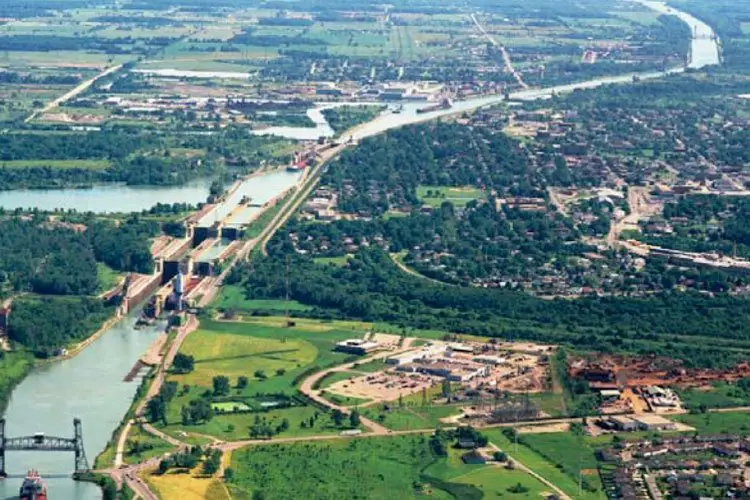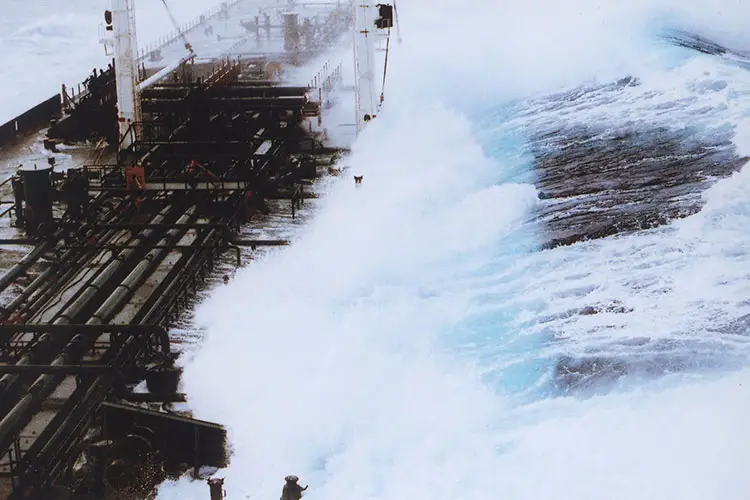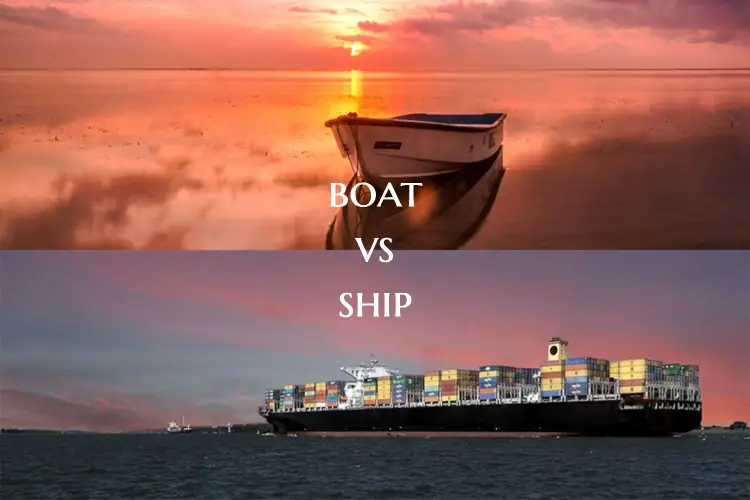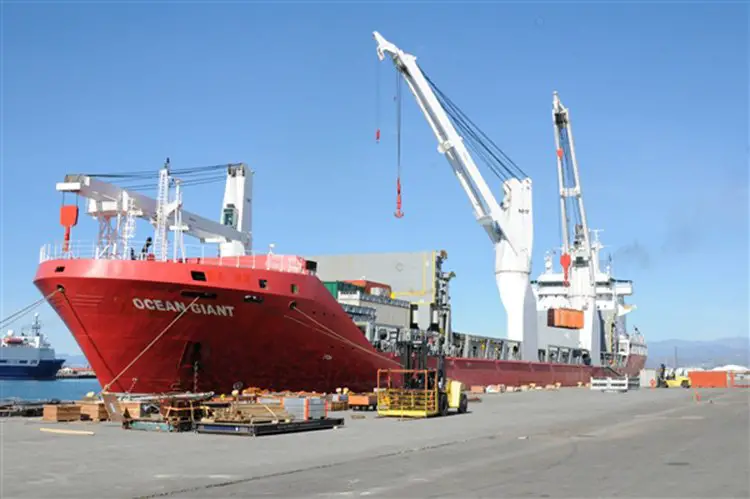Corinth Canal: A Peculiar Manmade Waterway
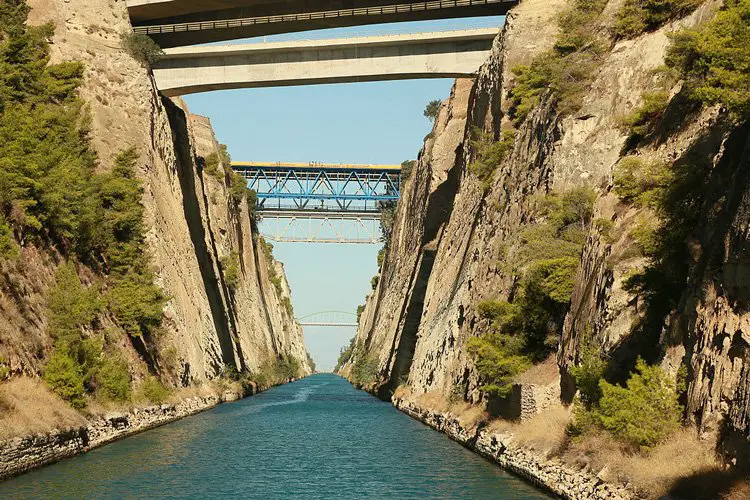
Canals are artificial waterways for shipping or irrigation as they reduce the distance of the routes. With the advent of other means of transport, canals are not used for transporting people but they still play a very important role in the transportation of goods.
As we had seen in the Ever Given getting stuck in the Suez Canal, any stoppage in major canals can lead to a disruption in global trade and commerce.
There are few notable man-made canals like the Panama Canal, Suez Canal, Kiel Canal, and many more. Corinth Canal is also one of those famous man-made canals in the world.
Let’s take a look at major factors like ancient history, construction and after construction information, and some facts about the Corinth Canal.
Introduction to the Corinth Canal
Canals are nothing but channels particularly used for water transportation or water transport vehicles such as ships, vessels, boats, etc. Canals are formed by geographical means or they can be man-made artificial waterways. Corinth canal is one of those artificial waterways and it is most famous as a tourist destination.
Location
The Corinth canal is located in Southern Greece. This narrow waterway serves as a link between the Gulf of Corinth that is in the Ionian Sea and the Saronic Gulf in the Aegean Sea.
The canal is made in such a way that it cuts through the isthmus of Corinth that splits the Peloponnese peninsula and mainland of Greece.
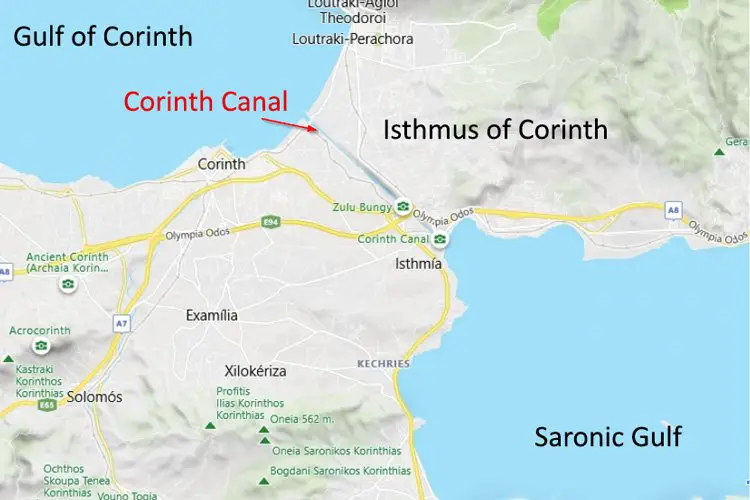
Isthmus of Corinth
Now, what is Isthmus of Corinth? The Isthmus of Corinth is a narrow strip of land that connects the Peloponnese peninsula with the rest of Greece and the canal is made through this isthmus. Thus, many will agree that the peninsula becomes an island of Greece.
The canal is formed through the isthmus at sea level, which means there is no elevation or depression in the water levels of the canal following the water level of the sea. Hence, there is no need for locks in the canal. Locks help ships to level with the other waterbody but since the canal is built at sea level, locks are not needed.
Dimensions
Its length is 6.4 kilometers and is only 21.4 meters wide. With a width of just 21.4 meters, the canal is very narrow for modern ships to pass through. Small boats and mid-sized ships can cross the canal. Due to the disadvantage of narrowness, the canal does not account for large economic importance. Although, it attracts many tourists from all over the world.
The idea of the construction of the canal was made way back in the 1st century AD. Many efforts were made to construct the canal at that time but to no avail as the project failed every single time. Later the construction again started in 1881 but it did not succeed at that time as well. The construction was hampered by geological problems and financial problems which bankrupted the original builders of the canal.
Finally, after all those failures the construction of the canal was completed in the year 1893 and first came to be used on July 25, 1893. But it did not attract the expected traffic because of its narrowness, navigational issues, and frequent landslides that occurred in the canal due to steep walls.
Due to these frequent landslides, the canal has to be periodically closed for the repair process. Thus, because of these obstacles, sailors avoided the route, reducing its economic importance.
History of the Canal
A long history is associated with the construction of the canal and we will take a look at it in the following points.
The history is written in three different phases to make it easy to understand.
Periander: Second Tyrant of the Cypselid Dynasty (7th century BC)
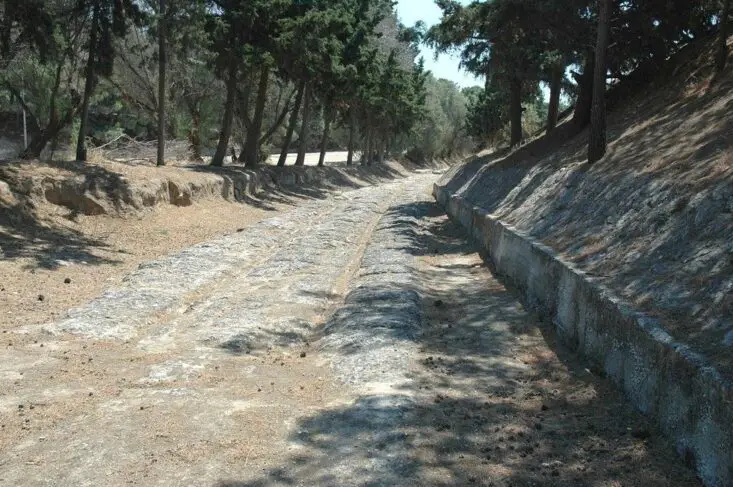
Many rulers of ancient times thought of cutting a passage through the isthmus. Although, the first person to propose the undertaking of such a project was a tyrant Periander. Tyrant means an absolute ruthless ruler who is not restrained by any law and Periander was a tyrant.
The project proposed by Periander got abandoned and hence he built an overland portage road which was simple and less costly. Portage is a way to carry watercraft or cargo over the land. So, Periander built this portage and it was named Diolkos, or a stone carriageway (paved track) through which the ships can be pulled from one end of the other end of the isthmus.
Diolkos was paved with hard limestone to withstand the weight of ships. It was almost 10 meters wide. The ships were loaded on some wooden cylinders and then rolled onto a wheels vehicle built purposely for ships. To reduce the weight of the ship, the cargo used to be unloaded before embarking their journey on Diolkos and transported separately by another road.
Periander had a different thought about this construction of Diolkos. His other thoughts were related to the immense cost of the project and the shortage of labor. He was also worried about Corinth getting robbed because it was an important transshipment port as goods can be imported, stored, and exported from the city of Corinth. The ship was then dragged all along the way across the isthmus. In the end, the ship was lowered into the sea and the cargo loaded again.
One can still find remnants of the Diolkos built by Periander in the modern canal.
Diolkos though of immense help had many limitations. Using Diolkos was very tedious and an expensive proposition. Larger ships could not use this trackway.
History of some other attempts for constructing the canal
Demetrius Poliorcetes, who belonged to the Antigonid Dynasty also planned to construct the canal, to improve his communication with other rulers around the world. Although he dropped this plan as his surveyors told that there are chances of heavy floods, they miscalculated the sea levels.
Apollonius of Tyana, a philosopher, predicted that whoever will propose the idea of building a canal through the isthmus will meet an illness. This became believable to people because of some incidents.
Three of the Roman rulers suffered violent deaths. Historians Plutarch and Suetonius wrote that Julius Caesar who was a Roman Dictator also thought of constructing the canal but was assassinated just before he could start the project and one more incident was of the third Roman Emperor, Caligula.
Caligula took the help of Egyptian experts to study the construction of the canal in 40 AD. However, the Egyptian experts gave a wrong conclusion that the Saronic Gulf is lower than the Corinthian Gulf and thus the digging of the canal through the isthmus could cause flood-like situations in the Aegina island. But the wrong conclusions were not the reason for the project to be abandoned. The reason project could not proceed was the assassination of Caligula before he could work on the project.
Nero: Fifth emperor of Rome (37 AD to 68 AD)
Nero started the construction of the canal personally by digging the ground with a pickaxe and removed a basket-load of soil. He was the first person to do so and he did that in 67 AD, furthermore, the project was abandoned as he died in 68 AD. The project was continued by the Roman Workforce.
The Roman workforce included 6,000 Jewish prisoners from the First Jewish-Roman War. They started the construction in three different parts. The first and second groups started digging 40 to 50 meters trenches from extreme ends of the isthmus. The third group took the work of drilling deep shafts on the raised mountain-like parts of the region to examine the quality of the rock. Furthermore, the rock was reused for the same motive.
Seutonius, the historian, wrote that the digging of the canal done by the Roman workforce was about a distance of 4 stades. Stade is a unit of measurement of length used in ancient Greek that equals 600 feet. According to his writings, the isthmus was dug to a distance of approximately 700 meters (2,300 ft) or one-tenth portion of the total distance across the isthmus.
Nero’s workers left a memorial of an attempt in the form of a relief of Greek divine Hercules. It can still be seen in the cutting of the canal. The modern canal followed the same course which Nero began with but the remains of that did not survive.
Later, after the Nero period, the project of the canal was considered in the 2nd century AD by Herodes Atticus who was a Greek philosopher and Roman senator but the project did not get underway. Further, Venetians who belong to the Republic of Venice also thought of the construction in 1687 but even they did not start the work on the project.
This was all about the history of the building of the canal.
Construction of the Modern Canal
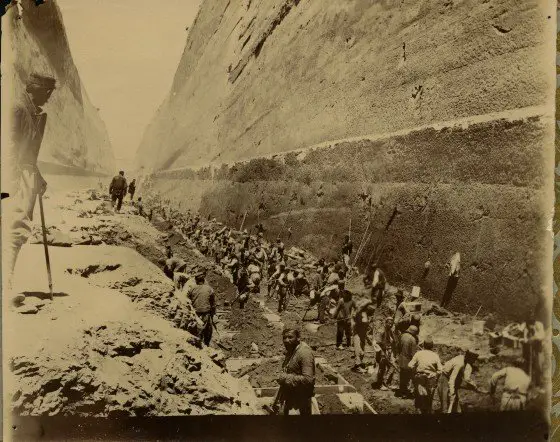
The construction of the canal was a difficult ride. The thought of the construction was revived when Greece got independence from the Ottoman Empire. The French engineer was asked to assess the project by a Greek statesman but the project again got abandoned because of its high cost which was not possible to arrange for a country that recently got independent.
Afterward, when the Suez Canal was built in 1869 the project of construction of Corinth Canal got inspiration and the Greek Prime Minister passed a law for the construction of the canal. Although, French banks refused to grant money because the French company once went bankrupt while attempting to dig the Panama Canal and later they again went bankrupt.
A fresh new start happened by granting a concession to operate and construct the canal for 99 years to Société Internationale du Canal Maritime de Corinthe in the year 1881. The inauguration of the construction took place in the presence of King George first of Greece on 23 April 1882. This company also went bankrupt after 8 years of working as their initial capital was 30,000,000 francs which account for 6 million US$ today and later they ran out of money. The head of the company went bankrupt and then the whole company.
After all of these failed attempts, the project was then transferred to a Greek company and the work resumed in the year 1890. The project of the construction of the Corinth Canal was completed on 23 July 1893, that is after a total of 11 years of work starting from the year 1882 to 1893.
Facts of the Corinth Canal

After the completion of the canal, it did not prove to be of great economic importance and it experienced a lot of difficulties regarding financial and operational aspects.
The canal is not suitable for large vessels and ships because of its narrowness. The canal serves as a difficult path also because of winds along its length and strong tides caused by the waters of the two gulfs. Due to these reasons, many ship operators choose not to go through this canal.
The annual traffic was expected to reach just below 4 million net tons but the traffic experienced by the canal in 1906 was just half a million net tons a year. It saw a rise in traffic of 1.5 million net tons by the year 1913. But then the First World War happened and the canal again witnessed a decline in traffic.
The other persistent problem in the canal is the heavily faulty nature of sedimentary rock along which it is cut. The high limestone walls of the canal are very unstable from the start. Due to frequent landslides, it was not open for navigation until November of 1893 even when the canal opened for service in July 1893.
165,000 cubic meters of masonry was used to build retaining walls along with more than half of the length of the canal across the water’s edges. The canal was closed for 4 years between 1893 to 1940 for the reason of maintenance and stabilizing of the walls. It was a whole lot of work when 41,000 cubic meters of materials fell into the waters of the canal and it had to be cleared out in the year 1923.
Huge damage was caused to the canal at the time of the Second world war. Furthermore, in the Battle of Greece, the parachutists and glider troops of Germany took control over the bridge on the canal. The capturing of the bridge was continued by the Britishers then again by the Germans and then the British destroyed the bridge. Some authors say that the destruction of the bridge was a lucky hit by the Britishers that triggered the explosion.
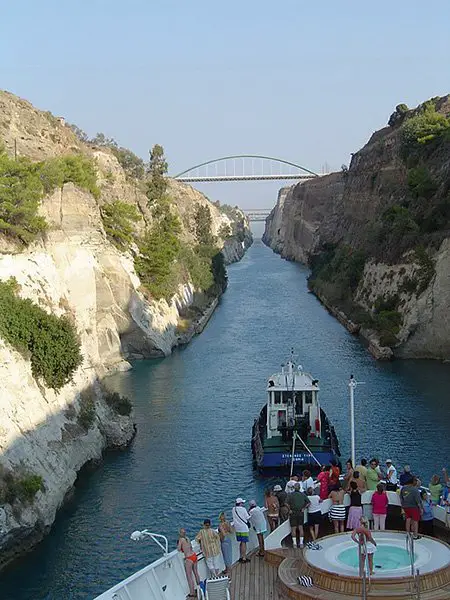
After some time a combined rail/ road bridge was built in place of the previous bridge. It was built by the 4th Railway Engineer Battalion which is a part of the Royal Italian Army’s Railway Engineer Regiment in just 25 days.
Later, Germans again destroyed the canal by using explosives to trigger landslides, destroyed the bridge, and dumped locomotives and other infrastructure materials into the canal to prevent further repair. The canal was cleared by the United States Army Corps of Engineers and the canal was opened for shallow-draft traffic on 7th July 1947 and for all traffic in September 1947.
A notable exception of the widest and longest ship to travel through the canal is MS Braemar that happened on 9th October 2019.
The canal is still not that of economic importance but is a famous tourist destination in today’s time. We saw all the history, construction, and facts about the canal in this article. All the important points are mentioned in the article.

